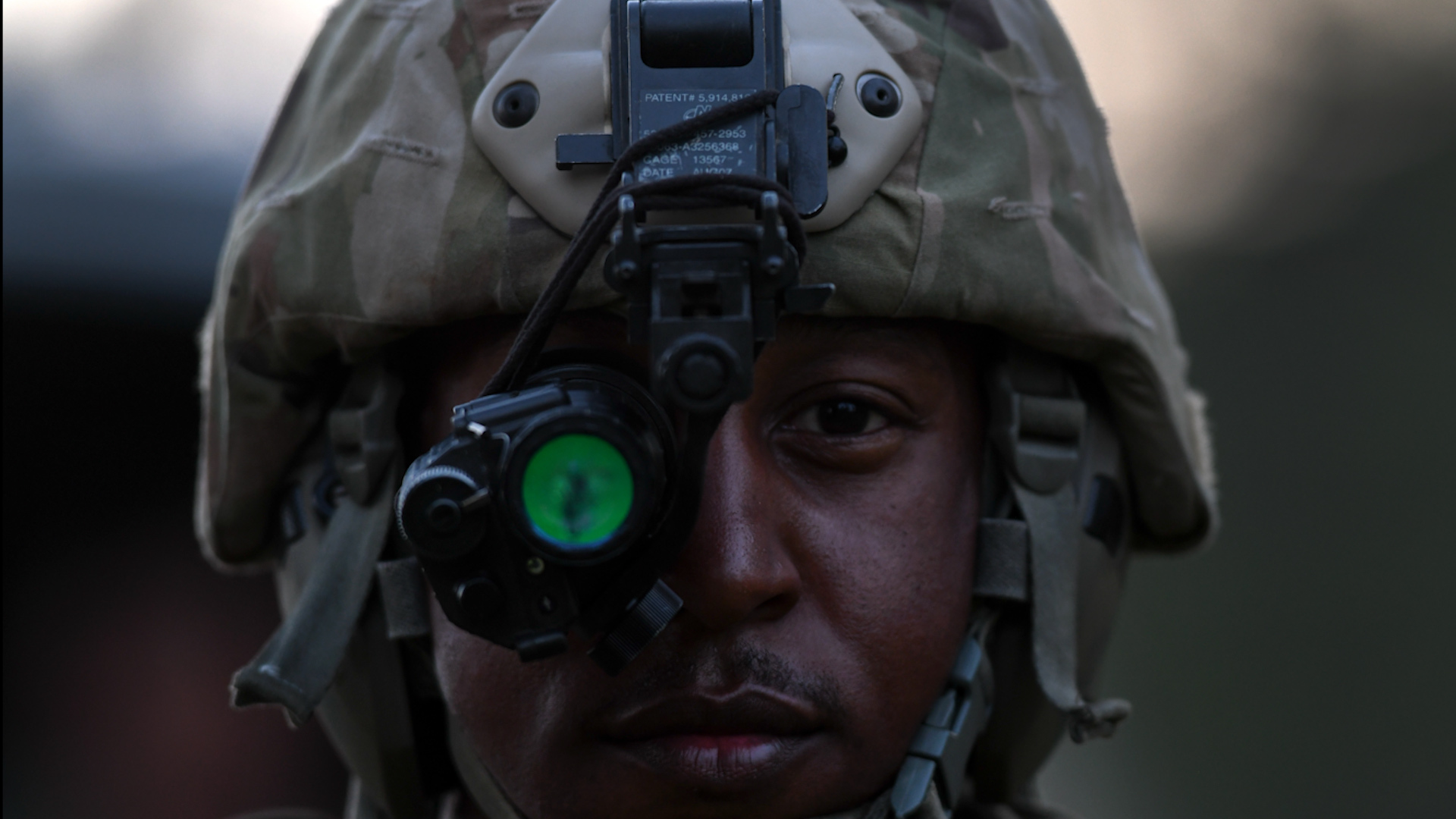
[RYAN ROBERTSON]
HELLO, AND WELCOME TO A SPECIAL EDITION OF WEAPONS AND WARFARE FOR STRAIGHT ARROW NEWS. I’M YOUR HOST, RYAN ROBERTSON, AND WE ARE COMING TO YOU TODAY FROM WESTBORO, MASSACHUSETTS, AN HOUR WEST OF BOSTON, AND IT’S THE HOME OF KOPEN.
KOPEN IS ONE OF THE LEADING COMPANIES IN THE WORLD OF MICRODISPLAYS, TECHNOLOGY THAT IS USED BY SOLDIERS, SAILORS, AIRMEN AND MARINES EVERY DAY. AND WHILE THE TECH IS SMALL, THE APPLICATION IS BIG, DELIVERING VITAL IMAGES AND INFORMATION TO WAR FIGHTERS ACROSS THE DOD.
AND TODAY, WE’RE GETTING A VERY SPECIAL UP CLOSE LOOK AT WHY AMERICA’S FRONT LINE OF DEFENSE STARTS WITH THE WORK THAT DONE HERE.
WITH ITS ROOTS FIRMLY PLANTED AT MIT AND DARPA, KOPIN WAS FOUNDED IN 1984, AND IN THE FORTY YEARS SINCE, THE TEAM HERE MADE A NAME FOR THEMSELVES BY CREATING INNOVATIVE SOLUTIONS IN AUGMENTED REALITY, VIRTUAL REALITY, AND WEARABLE TECH.
WHAT SETS KOPIN APART FROM OTHERS IN THE FIELD IS ITS EXPERTISE IN THIN-FILM TRANSISTOR DISPLAYS AND LIQUID CRYSTAL ON SILICON TECHNOLOGIES. SAID ANOTHER WAY– THEY PROVIDE THE KNOW-HOW AND THE HARDWARE FOR HIGH-RESOLUTION MICRO DISPLAYS THAT FIT IN EVERYTHING FROM MILITARY GEAR TO CONSUMER ELECTRONICS.
[MICHAEL MURRAY]
“We are a semiconductor company by heart. We develop microdisplays here in Westboro. Our LCD technology comes out of this building. But we also develop three other types of microdisplays: our Oleg capability, micro led, as well as Sparrow electric liquid crystal and silicon. And we now have a fifth generation of microdisplay that we’re bringing to market very soon.
[RYAN ROBERTSON]
“So when we’re talking about microdisplays, I mean, you hear the word, but most people probably have these in their everyday lives that just don’t even know about it yet, right?”
[MICHAEL MURRAY]
“No, exactly, right. So if you have an Oculus at home or an Apple Vision Pro, those have microdisplays based inside them, that’s correct.”
[RYAN ROBERTSON]
MICHAEL MURRAY IS KOPIN’S CHAIRPERSON, CEO, AND PRESIDENT. FOR HIM, KOPIN’S WORK WITH OUR NATIONAL DEFENSE… AND WHAT THOSE ENDEAVORS BRING TO OUR NATION’S SOLDIERS, SAILORS, AIRMEN, AND MARINES IS A VITAL PIECE DRIVING THE COMPANY.
[MICHAEL MURRAY]
“It feels great. And this is the mission that come that the company has. It’s all about vision beyond imagination, and making sure there are men and women of our allies and our armed forces come home. So the thought process is, if we can have our ability and our Armed Forces see their adversary before they see them, they’re more likely to come home safe. And that’s the ethos of the company. ”
[RYAN ROBERTSON]
IN AN ERA WHERE YOU CAN BUY A MASSIVE 98 INCH, 4K TELEVISION FOR ROUGHLY WHAT IT COSTS TO TAKE A FAMILY OF FOUR TO TWO NFL GAMES, YOU MIGHT BE ASKING YOURSELF, WHAT’S THE BIG DEAL ABOUT A MICRO DISPLAY?
WELL, YOU CAN’T EXACTLY FIT A MONSTER SCREEN INSIDE A TANK OR A JET FIGHTER–AND YOU CERTAINLY DON’T WANT TO BE LUGGING ONE AROUND AT THE SQUAD LEVEL.
BUT IN WARFARE–YOU CAN’T HIT WHAT YOU CAN’T SEE, AND AS NIC PETERSON, KOPIN’S DIRECTOR OF BUSINESS DEVELOPMENT AND WAR FIGHTER VISION EXPLAINS, KOPIN MAKES IT POSSIBLE FOR END USERS TO SEE THE BATTLESPACE IN A VARIETY OF WAYS.
[NIC PETERSON]
“What we’re showing here is the micro LED. It’s the holy grail of display technology. It doesn’t struggle where some of the other displays do struggle. In other words, for this in augmented reality, it’s all about really high brightness and efficiently getting that brightness out of the display and into your eye. And so the micro led here, if you look through that, these are non optimized optics, but they’re just low NRE. It was paired well with the micro led that we produced, yeah, if you want to take a look in there, low NRE. So it didn’t cost us a lot to integrate the display with a pair of optics we already had on the shelf to show what we’re showing. What we’re showing is really, really bright augmented reality. So if you look through there now, you can still see my hand, right? Yeah, and you can see right through the optics, but you can also see a very vivid monochrome image, yeah, that’s because the micro led provides, I guess, almost unlimited brightness, given what we see from other display technologies, and that’s really beneficial for augmented reality.”
[RYAN ROBERTSON]
“Let’s, like, explore that, right? Why is it for augmented reality, we’re talking about putting a digital image or something overlaid with what you actually see, right? So when I’m looking through that, I see, I saw your hand. If I’m looking at a I can see the person. But I’m also with the augmented reality, putting stuff over that image. Why does the brightness matter?”
[NIC PETERSON]
“Well, imagine I’m looking at a white building or a bright sky with white clouds in it. Okay, so that’s all gonna have a challenge where I’ve got to create enough contrast brightness from my display to still see what else I want to augment on that reality. So that’s where brightness matters.”
[RYAN ROBERTSON]
“So if I’m a pilot a pilot, you know, saying, Oh, I don’t know, maybe the Arctic or PACOM, right, where there’s clouds, and I need to be able to know the information without squinting or trying to it just needs to be readily available.”
[NIC PETERSON]
“For a full ull brightness daytime environment. You need a lot of brightness from the display to get that AR to be quickly recognizable by the end user. So that’s where micro LED is so important. Now alternatively, this also can go very, very low brightness. So now, flying a mission at night, and I don’t want a lot of brightness, my eyes are already absorbed inside of the environment I’m in, which is very dark, but I still want my augmented reality, and so it has to be able to do that wide dynamic range micro LEDs capable of that as well.”
[RYAN ROBERTSON]
AT THIS POINT YOU MIGHT BE WONDERING HOW A MICRODISPLAY GOES FROM AN ITEM ON AN ORDER SHEET TO AN ACTUAL PIECE OF HARDWARE IN THE WARFIGHTERS HANDS. FOR THAT WE TOOK A TOUR OF KOPIN’S 74,000-SQUARE-FOOT FACILITY WITH RAY SCHUBNEL, VICE PRESIDENT OF MANUFACTURING AND QUALITY.
“Semi-conductor industries will make their manufacturing processes around either an eight in wafer or a 12 inch wafer…”
[RYAN ROBERTSON]
WHILE SCHUBNEL SHOWED US AROUND KOPIN’S DESIGN AND MANUFACTURING CENTER, HE EXPLAINED THE FACILITY BOASTS TWO CLEAN ROOMS, SPECIFICALLY A CLASS 10 AND A CLASS 1,000. THE DIFFERENCE BETWEEN THE TWO REVOLVES AROUND THE NUMBER OF PARTICLES ALLOWED IN THE AIR PER CUBIC METER.
IT’S A LITTLE LIKE SCORING IN GOLF–THE LOWER THE NUMBER, THE MORE INTENSE THE CLASSIFICATION.
SO, IN A CLASS 10 CLEAN ROOM, THERE CAN BE A MAXIMUM OF 10 PARTICLES THAT ARE POINT FIVE MICRONS OR LARGER FOR EVERY CUBIC METER OF AIR. A HUMAN HAIR, ON AVERAGE, IS AROUND 70 MICRONS…SO, TO PUT IT VERY SIMPLY–IT’S A HYPER-CONTROLLED ENVIRONMENT WITH EXTREMELY LOW LEVELS OF CONTAMINANTS, MAKING IT SUITABLE FOR KOPIN’S HIGH-PRECISION WORK.
ON THE OTHER HAND, A CLASS 1,000 CLEAN ROOM ALLOWS UP TO 1,000 PARTICLES OF THE SAME SIZE IN A CUBIC METER. WHILE STILL QUITE CLEAN, IT HAS A HIGHER TOLERANCE FOR AIRBORNE PARTICLES COMPARED TO THE CLASS 10 ROOM.
BEFORE ENTERING EITHER ROOM, THOUGH, THE TECHNICIANS SUIT UP FROM HEAD TO TOE IN A STAGING AREA, WHICH LEADS TO MULTIPLE CHAMBERS DESIGNED TO REMOVE ANY POTENTIAL CONTAMINANTS.
[RAY SCHUBNEL]
“So this actually knocks it all off. So it goes down to the floor you suit up, and you’re not carrying it potentially on you or on your suit, because if it’s floating around in the air, and then you walk through, it would be on your suit. So this is just constantly dropping it down onto the floor. And we’ve got, like a deluxe one right before you go into the fab that’s really knocking it down. And then we go through, like a wind tunnel. That’s just one more extra time making sure. So by the time we’re going into the clean room, there’s very little exposed there’s virtually no dust on you, and that helps maintain that class 10 cleanliness of the air in the clean room.”
[RYAN ROBERTSON]
ONCE INSIDE KOPIN’S ARRAY OF LCD, OLED, F-L-COS, AND MICRO LEDS BEGIN TO TAKE SHAPE. THE PROCESS STARTS BY GROWING TINY RED, GREEN, AND BLUE LEDS ON WHAT’S KNOWN AS A WAFER, THEN TRANSFERRING THOSE MICRO-LEDS TO A BACKPLANE WHERE EACH LED IS POSITIONED TO FORM A PIXEL. FROM THERE THE UNITS ARE CONNECTED TO THE NECESSARY CIRCUITRY TO CONTROL THEIR ILLUMINATION. IT ALL REQUIRES HIGHLY ACCURATE AND SPECIALIZED TECHNIQUES TO ACHIEVE THE DESIRED PIXEL DENSITY AND IMAGE QUALITY.
WE WEREN’T ABLE TO ENTER THE CLEAN ROOMS, NATIONAL SECURITY AND ALL–BUT WE WERE ABLE TO OBSERVE THE WORK BEING DONE THROUGH SOME OBSERVATION BAYS.
[RAY SCHUBNEL]
“The machines in the middle on the left are putting this flex cable on, so now we can light it up and provide electricity. And like we said, and the display is this will have, this one probably has 400,000 pixels on it, so you’re literally controlling each and every pixel, and we’re going to test brightness, contrast, making sure that every pixel works in this location, because we might be sending out a completed display to a customer, or we might be moving it to base six to start building it up into a product. So it’s got to be right before either one of those things happen. So a lot of testing happens. Happens here. If it’s going to be a display, it’ll get full testing here, and then it’ll get full testing one more time before shipment in a lab that you’re going to see. If it’s going to be putting into a higher level assembly, it gets fully tested here, goes into the full up assembly, and then gets fully tested there. So lot of duplication.”
[RYAN ROBERTSON]
THE SHEER LEVEL OF ATTENTION PAID TO EVERY STEP IN THE MANUFACTURING PROCESS IS BEYOND IMPRESSIVE. ONE AREA WHERE WE WERE ABLE TO GET A CLOSER LOOK AT WHAT A DISPLAY GOES THROUGH BEFORE HEADING OUT THE DOOR WAS THE FOREIGN OBJECT DEBRIS, OR FOD, INSPECTION. THIS IS WHERE THE CRITICAL PIECES ARE INSPECTED YET AGAIN, ONLY THIS TIME UNDER AN INCREDIBLY POWERFUL MICROSCOPE.
[RAY SCHUBNEL]
“The camera is set up to be a little bit better than really, really good people. So we could make the camera super good, and it would see a lot of FOD that operators would never see. Or we could make it terrible, and you wouldn’t see anything. We have it dialed in to be a little bit better than the human eye. So what we would do is we would take our traveler and say, Okay, I see a piece of fod, and they would mark it, and then it would go to a final inspector that said, hey, is this acceptable? Because it’s outside of the critical area, it’s a certain size. Is this acceptable? Well, this, to us, is actually a large piece of fod, so it wouldn’t be acceptable.
[RYAN ROBERTSON]
“That’s a large piece? That is a large little speck?”
[RAY SCHUBNEL]
“That little speck.”
[RYAN ROBERTSON]
SIDE NOTE–SCHUBNEL WAS SO IMPRESSED WITH MY ABILITY TO SPOT FOD HE SAID I COULD HAVE A CAREER IN THE FIELD. ALRIGHT, BACK TO THE IMPORTANT STUFF.
AFTER PASSING KOPIN’S RIGOROUS TESTING AND INSPECTIONS, EACH APPROVED MICRODISPLAY MOVES ON TO FINAL ASSEMBLY. WHERE EACH DISPLAY ENDS UP IN EITHER A PILOT HELMET, OR AN ARMORED VEHICLE TARGETING SYSTEM, MAYBE A SOLDIER-CENTRIC THERMAL WEAPON SYSTEM, POSSIBLY MEDICAL DEVICES FOR SURGEONS, OR HIGH-END A-R/V-R HEADSETS. EVEN TRAINING SIMULATORS NEED THE MICRODISPLAYS
[RYAN ROBERTSON]
“Correct me if I’m wrong. But Kopin is one of the only American owned companies doing anything in this realm, right.
[MICHAEL MURRAY]
“As far as I know, we are the last US-owned micro display company, and we define a microdisplay is two inches in diagonal and below. So we’re very unique. We’re also one of the only companies that build four different types of microdisplays, plus the fifth microdisplay, which is our neural display architecture, and again, that can go between micro OLED or micro-led deposition. So we’re very, very unique. We’re focused on defense because that’s where we see the greatest value for our technology. But now we’re seeing medical, industrial, and consumer spatial devices carrying on and taking up some of our technology and creating demand on the company.”
[RYAN ROBERTSON]
ONE WAY KOPIN LOOKS TO PROVIDE THE KIND OF TOOLS AMERICAN TROOPS NEED IS BY LEANING ON THOSE WHO WERE IN A POSITION TO NEED THEM. ALLAN WIGHT IS A PROGRAM DIRECTOR FOR KOPIN AND A NAVY VETERAN. HE SAYS THAT CONNECTION HELPS DRIVE THE MISSION.
[ALLAN WIGHT]
“I’m not just putting something on Amazon for somebody to go buy, right? We’re custom providing custom solutions so that the warfighter can do their job effectively, efficiently and get home to their families. So you know, to me as a veteran, right? That hits home pretty hard as well, but ultimately, even even the team members here, you know, just driving that message home every day and taking pride in their work and getting that feedback from the end user or our customers that have a low return rate, and it’s because of them and what they do and their focus on quality”
[RYAN ROBERTSON]
IT’S A FOCUS THAT EXTENDS BEYOND THE WALLS OF THEIR HOME OFFICES. CHARLES FERRERA IS A FORMER SPECIAL OPERATOR WHO SPENT TIME IN THE MIDDLE EAST. HE’S THE KIND OF GUY THAT MAKES THINGS GO BUMP IN THE NIGHT.
NOW HE’S INVOLVED WITH PRODUCT DEVELOPMENT AND DESIGN FOR KOPIN. FERRERA SAYS GETTING THESE PRODUCTS INTO THE HANDS OF END USERS IS CRUCIAL TO THE NEXT WAVE OF AMERICAN WARFIGHTERS.
[CHARLES FERRERA]
“So product development cycle, yeah, I may take a product and I’m going to give it to you, and I’ve designed it to what I think is best. I give it to you when I say, go run this for a while, and in return, I want an after action review from you on what you liked, what you didn’t like, and let’s get together, have pizza and a beer and talk about it, or let’s go to the range, or let’s go run a, you know, a training exercise. Let me better understand what it is that you’re truly asking for that interaction with those active end users. Is, you can’t put a price tag on that. There’s absolutely no way to do that, but you have to be open minded. You have to be flexible. So there’s a saying, There’s a phrase that came up, I don’t know, 2019 ish was hardware enabled, software defined. And if we can do that, so we plan, we engineer for the future to where now, whatever’s in the realm of what you can dream up, or you can think of now becomes more software side. Right, so long as I have enough vision and I foresight and planning, pre planning, saves time and money. So if I can do that and put in the correct hardware, now, I just need enough guys to know how to do zeros and ones to talk with me as an SME or the active end users, and we can get together, and now we can create a nice platform for those individuals, and we can develop that into something and custom tailor it for them. There’s always going to be constant feedback.”
[RYAN ROBERTSON]
KOPIN’S LEADERSHIP TELLS US THAT FEEDBACK IS CRUCIAL IN NOT ONLY IMPROVING THE PRODUCTS THEY CURRENTLY MAKE BUT IN PUSHING THEIR TEAM TO BRING NEW INNOVATIONS, LIKE THAT NEW MICRODISPLAY, TO THE TABLE.
[MICHAEL MURRAY]
“The fifth type is actually our software defined AI enabled back plane, called neural display. And it can be different types of displays. It’s actually the back plane that really makes it work. That’s where all the circuitry and brains are, and the also the imaging pixels that we pick up on your eyes, so the white, gray and black of your eye tracking. So that technology is a back plane that we can deposit OLED or micro LEDs on.
[RYAN ROBERTSON]
And what does that capability bring you, if you can deposit different types of material on it, like what kind of capabilities would that provide?
[MICHAEL MURRAY]
So we actually solve a number of problems with this type of technology. If you have been following, as an example, the Oculus or Apple vision Pro or the Ivas system and the military, what we’re solving is eye tracking, but more specifically, what we’re tracking is actually your physical response to other stimuli. As an example, fight or flight. When an individual gets into an engagement on the battlefield, their neurological response is called fight or flight. When that happens, your people pupils dilate at a very large rate, and the amount of visible light that you can take into your eye at that point in time becomes actually a lot less. So in reality, the micro display doesn’t know that you the physical being, has changed. So what we’ve done is taken tiny, little pixels that are inside the micro display, and we’re imaging your eye just the white, gray and black. That’s it. And what we’re able to do with that information is dynamically tune the brightness and the contrast of the display in real time, or at least very close to real time. You have about 500 microseconds to make those changes before the physical brain feels something that it doesn’t like.”
[RYAN ROBERTSON]
IF THAT SOUNDS LIKE A LOT, THAT’S BECAUSE IT IS. FORTUNATELY, BEN IVALDI, AN ELECTRICAL ENGINEER FOR KOPIN, WAS ON HAND TO WALK US THROUGH THIS PIONEERING PIECE OF TECH.
[BEN IVALDI]
“So basically, the neural display is a micro display with integrated sensors and AI processing built right in, and then, so by having all of that in the display, the display is able to monitor the user’s eye and any responses that it has to stimulus.
[RYAN ROBERTSON]
“Why is it important to monitor, to monitor somebody’s eye and see what is stimulating our eye?”
[BEN IVALDI]
“Yep, so certain biological responses cause your pupil to dilate, like fight or flight. So if you’re imagining a fighter pilot who’s flying sees an enemy, suddenly, you know, gets nervous. His pupil gets huge, and he’s wearing a headset that has a display. A display, and it’s suddenly that display is way too bright for him and is now impeding his vision. So if we’re able to have a display that knows that this is happening, it can adjust itself, compensate for the user, and get dimmer. And then also, by integrating all of these, the sensor and the processing right into the display, we’re able to save on power, size, weight, you know, cost, as opposed to systems that have separate components for all of those.
[RYAN ROBERTSON]
KOPIN’S CEO, MICHAEL MURRAY, TELLS US THERE ARE THREE STEPS TO MAKING THE NEURAL DISPLAY A REALITY, AND THEY ALREADY TACKLED THE FIRST TWO. FIRST, THEY BUILT THE MICRODISPLAY WITH AN IMAGING PIXEL IN WHAT’S CALLED A SUB-PIXEL. AND SECOND, THEY BUILT THEIR OWN A-I SOFTWARE, A COMPANY FIRST. BUT IT’S THE THIRD STEP THAT MURRAY SAYS WILL BE THE PROJECT’S BIGGEST CHALLENGE.
[MICHAEL MURRAY]
“Number three is really tough. That’s putting those two things together and creating a demonstrable display that runs the AI engine. And I’m very pleased to report that we’re on track with that so far, but it’s going to get tricky into 2025 to actually develop that, put it into some applications, start letting people use it, create the AI data lake that we’re going to need so we can make better decision trees on our AI. And that’s the next step. But so far, we’re well on track, and we’ve been able to prove out some of the theories in this technology that it works, but most importantly, it solves size, weight, power consumption, and the overall system cost comes down using this technology. And it’s a brilliant display. It looks great. So being able to add this capability in a micro display is, I think, revolutionary, and we’re very unique because of it.”
[RYAN ROBERTSON]
YOU KNOW LOOKING BACK AT EVERYTHING WE SAW AND LEARNED ABOUT AT KOPIN–IT MAKES ME THINK OF THE TERM BIG PICTURE.
IT’S A COMMON PHRASE WE’VE ALL PROBABLY USED FROM TIME TO TIME–
AND ON THE SURFACE IT MAKES SENSE, YOU KNOW.
BUT IN REALITY, EACH BIG PICTURE IS MADE UP OF SMALLER, LITTLE PICTURES, EACH ADDING THEIR OWN CONTEXT AND INSIGHT INTO THE WHOLE STORY.
NOT UNLIKE THE WORK KOPIN INDUSTRIES IS DOING.
WE WANT TO SEND A BIG THANK YOU TO KOPIN’S MICHAEL MURRAY AND LISA SAFFRON FOR OPENING UP THEIR DOORS TO US AND ALLOWING US TO SEE WHAT THEY DO EVERY DAY.
FOR SENIOR PRODUCER BRETT BAKER, VIDEO EDITOR BRIAN SPENCER AND GRAPHICS ARTIST DAKOTA PATIO. I’M RYAN ROBERTSON WITH STRAIGHT ARROW NEWS. SIGNING OFF.











